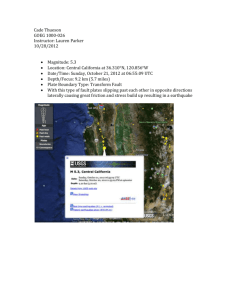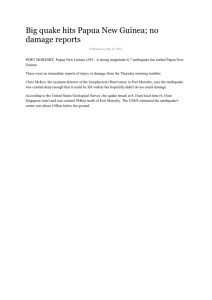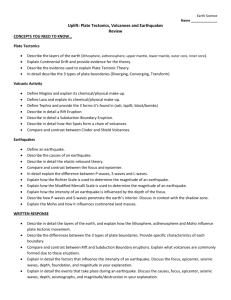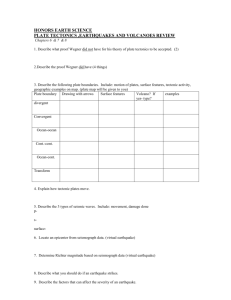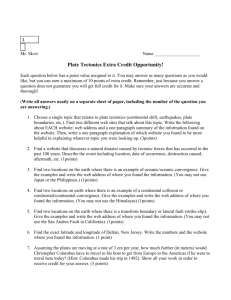Magnitude 7.5 NEW BRITAIN REGION, PAPUA NEW GUINEA
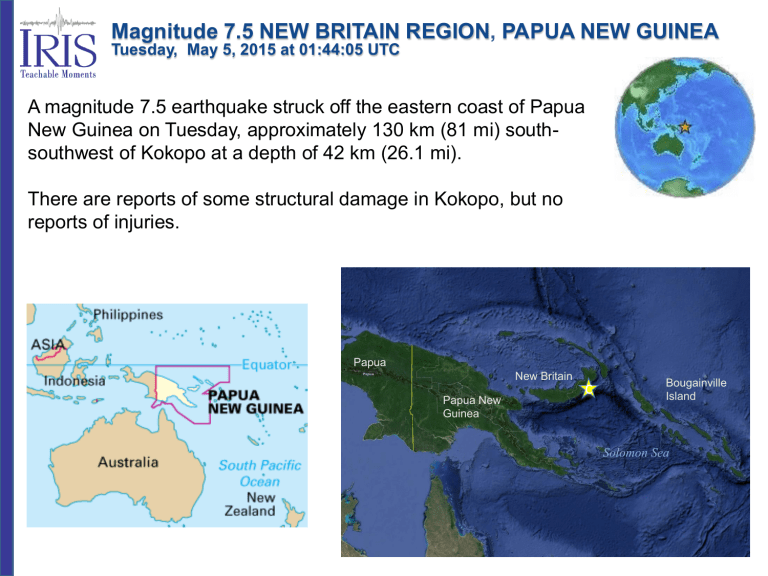
Magnitude 7.5 NEW BRITAIN REGION , PAPUA NEW GUINEA
Tuesday, May 5, 2015 at 01:44:05 UTC
A magnitude 7.5 earthquake struck off the eastern coast of Papua
New Guinea on Tuesday, approximately 130 km (81 mi) southsouthwest of Kokopo at a depth of 42 km (26.1 mi).
There are reports of some structural damage in Kokopo, but no reports of injuries.
Papua
Papua New
Guinea
New Britain c
Solomon Sea
Bougainville
Island
Magnitude 7.5 NEW BRITAIN REGION , PAPUA NEW GUINEA
Tuesday, May 5, 2015 at 01:44:05 UTC
No Tsunami Warnings, Advisories or Watches are in currently in effect.
Following the earthquake, the Pacific Tsunami Warning Centre said hazardous tsunami waves were possible within 300 km of the epicenter, and warned that 0.3 to
1 meter tsunami waves would possibly hit some coasts of Papua New Guinea.
To ensure early detection of tsunamis and to acquire data critical to real-time forecasts, NOAA has placed Deep-ocean Assessment and Reporting of Tsunami
(DART) stations at sites in regions with a history of generating destructive tsunamis.
The Port Moresby Observatory reported some tsunami oscillations in Rabaul Harbor.
Magnitude 7.5 NEW BRITAIN REGION , PAPUA NEW GUINEA
Tuesday, May 5, 2015 at 01:44:05 UTC
The Modified-Mercalli Intensity scale is a twelve-stage scale, from
I to XII, that indicates the severity of ground shaking.
The nearest islands experienced moderate to very strong shaking from this earthquake.
Modified Mercalli Intensity
Perceived
Shaking
Extreme
Violent
Severe
Very Strong
Strong
Moderate
Light
Weak
Not Felt
Image courtesy of the US Geological Survey
USGS Estimated shaking Intensity from M 7.5 Earthquake
Magnitude 7.5 NEW BRITAIN REGION , PAPUA NEW GUINEA
Tuesday, May 5, 2015 at 01:44:05 UTC
USGS PAGER
Population Exposed to Earthquake Shaking
The USGS PAGER map shows the population exposed to different Modified
Mercalli Intensity (MMI) levels.
12,000 people were exposed to severe shaking while 149,000 were experienced strong to very strong shaking from this earthquake.
The color coded contour lines outline regions of MMI intensity.
The total population exposure to a given MMI value is obtained by summing the population between the contour lines. The estimated population exposure to each MMI Intensity is shown in the table.
Image courtesy of the US Geological Survey
Magnitude 7.5 NEW BRITAIN REGION , PAPUA NEW GUINEA
Tuesday, May 5, 2015 at 01:44:05 UTC
In this region of the
Pacific, the Australian
Plate is subducting under the overriding Pacific
Plate.
Image courtesy of the US Geological Survey
In detail, there are numerous microplates
(fragments of larger plates). Arrows show net plate motion relative to the Australian Plate.
Image courtesy OSU; simplified from Hamilton (1979)
Magnitude 7.5 NEW BRITAIN REGION , PAPUA NEW GUINEA
Tuesday, May 5, 2015 at 01:44:05 UTC
This region of tectonic microplates accommodate convergence between the larger Australia and the Pacific
Plates. The Solomon Sea Plate moves slightly faster and more northeasterly with respect to the Pacific Plate than does the Australia Plate due to seafloor spreading in the Woodlark Basin.
Papua
New
Guinea
Latangal
Island
New Britain
Bougainville
Island
Pacific Plate
North Bismarck Plate
South Bismarck
Plate
Solomon Sea Plate
Woodlark Basin
Australian Plate
Cross-section of the subduction zone below New
Britain.
From Johnson (1976)
Magnitude 7.5 NEW BRITAIN REGION , PAPUA NEW GUINEA
Tuesday, May 5, 2015 at 01:44:05 UTC
According to the USGS, this earthquake occurred as the result of thrust faulting on or near the plate boundary interface between the subducting Australia and overriding Pacific Plates.
At the location of the earthquake, the
Australia plate moves towards the eastnortheast at a velocity of 105 mm/yr with respect to the Pacific plate, and begins its subduction into the mantle beneath New Britain at the New Britain
Trench south of the earthquake.
Regional tectonic complexities involving the convergence of the Australian and Pacific Plates.
The tension axis (T) reflects the minimum compressive stress direction.
The pressure axis (P) reflects the maximum compressive stress direction.
W-phase Moment Tensor Solution
Images courtesy of the U.S. Geological Survey
Magnitude 7.5 NEW BRITAIN REGION , PAPUA NEW GUINEA
Tuesday, May 5, 2015 at 01:44:05 UTC
This earthquake is shown by the blue star on the map at the right. It is a seismically active area with frequent large earthquakes.
The Australian Plate subducts at a steep angle towards the north beneath the Pacific Plate at the
New Britain Trench shown below in a S-N cross section.
Image source:
U.S. Geological Survey
Open-File Report 2010 –1083-H
Magnitude 7.5 NEW BRITAIN REGION , PAPUA NEW GUINEA
Tuesday, May 5, 2015 at 01:44:05 UTC
This earthquake is the latest in an ongoing sequence of seismicity in the same region over the past week. The image on the right is a map of 13 earthquakes in the past week prior to the M7.5, the image on the left is the seismicity of the previous week.
M 7.5
Regional Seismicity April 28 – May 5, 2015
Regional Seismicity April 21 – 28, 2015
Magnitude 7.5 NEW BRITAIN REGION , PAPUA NEW GUINEA
Tuesday, May 5, 2015 at 01:44:05 UTC
The record of the earthquake on the University of Portland seismometer (UPOR) is illustrated below. Portland is 10,068 km (6256 miles, 90.7
° ) from the location of this earthquake.
Following the earthquake, it took 12 minutes 58 seconds for the compressional P waves to travel a curved path through the mantle from the earthquake to Portland, Oregon.
S waves are shear waves that follow the same path through the mantle as P waves and took 23 minutes 51 seconds to arrive.
Surface waves, both Love and Rayleigh, traveled the 10,068 km (6256 miles) along the perimeter of the Earth from the earthquake to the recording station.
Magnitude 7.5 NEW BRITAIN REGION , PAPUA NEW GUINEA
Tuesday, May 5, 2015 at 01:44:05 UTC
Teachable Moments are a service of
IRIS Education & Public Outreach and
The University of Portland
